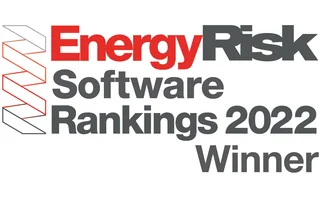
KWA Analytics spearheads CTRM modernisation drive


KWA’s continued expansion into next-generation technology reaps rewards for clients and has helped the firm dominate in the 2022 Energy Risk Software Rankings

Unlike many of its competitors, KWA Analytics saw 2021’s extreme market volatility, heightened geopolitical uncertainty and the ongoing effects of the Covid-19 pandemic on working patterns as a chance to expand its services, technology and expertise. This was key to its achieving the number one position in all nine technology advisory categories in the 2022 Energy Risk Software Rankings, according to KWA Analytics Americas’ executive vice-president of sales, Will O’Brien.
“We expanded throughout the first and second years of Covid-19, which was a big differentiator for us,” he says. While many companies took a cautious approach, KWA Analytics prepared for the huge change that was to come by taking “a modern approach across the board”, he told Energy Risk.
Specifically, the company stepped up its recruitment of already highly qualified people and trained them in all aspects of the technology, software and implementation challenges facing clients in the energy and commodities trading markets, and capital markets and cross-assets space.
“It’s vital for us that our people are able to offer the very best advice and solutions to all types of clients – from central banks and asset managers to more boutique operations and to producers across the full spectrum of asset classes – as our business is roughly evenly split between energy and commodities trading on the one hand, and capital markets and cross-assets on the other,” says O’Brien. “This is why we give all our people full cross-asset functional training, and this is a major part of what differentiates us from being just another traditional consultancy shop.”
The three-pronged approach
From the original founders of the company to its most recent hires, KWA boasts a uniquely wide-ranging skill set for this space that enables the firm to look at a client’s needs across its entire business and offer the optimal solutions for it, O’Brien says.
“We have the three-pronged approach to our business solutions that we bring to clients as a trusted adviser. First, we have the original architects, product managers and salespeople of the incumbent commodity trading and risk management [CTRM] platforms. Second, we have the combination of former people from the businesses – the end-users – who have actually interacted with these systems. And third, we have people from the more traditional big-four, big-five firms.”
“All of these people understand the software, the most modern technology and the optimal delivery methods, and there’s no other vendor out there with those three pillars.”
To fulfil client needs across borders, KWA Analytics has also continued to expand its global footprint over the past two years. As well as its core centres in London, New York, Houston, Calgary, Vancouver and India, the firm has a growing presence in Mexico and Singapore.
The expansion in geographies, personnel, and products and services was partly a result of the ongoing changes to working patterns that occurred because of the pandemic, O’Brien emphasises.
“The big challenge in the first year of Covid-19 was enabling clients to work securely in a remote capacity, and that was a very useful foundation for many of them continuing to do the same in the second year,” he says. “But, also in that second year, clients realised they’d made all these investments in the IT landscape and established their processes so they could run their businesses, and now they needed the tools so they could modernise their trading and risk platforms.”
For many clients, this meant they had to address the relative ineffectiveness that resulted from their legacy technology landscape, according to O’Brien.
“A lot of the big problems we see arise because a client’s legacy platform or newer ecosystem approach may allow only for a certain commodity or certain asset class to be housed in one system – and then another commodity has to be housed in a different system,” O’Brien says. “That precludes any meaningful communication between the two areas and limits their ability to do the more advanced analytics accurately, such as value-at-risk and even stress-testing.”
Price swings amid volatile markets
The deficiencies in these legacy technology landscapes were starkly exposed last year as the commodities markets became exceptionally volatile. Price swings of 5% or more in a day were seen frequently in crude oil markets throughout the year, while Storm Uri in Texas caused spiralling gas and electricity prices in February 2021.
“These huge price swings meant an absolute need for real-time monitoring and reporting of trading positions, counterparty limits, margin requirements, and so on. And, in this context, having a modern technology landscape was essential,” O’Brien says.
“The best next-generation vendors are cloud-based and open-sourced platforms that allow users to build what they need,” he says. “They can interface to exchanges, other CTRM systems, data vendors and financial engineering solutions, such as proprietary pricing models and risk analytics, while supporting applications developed not just using Python but also C++, C#, .Net, and so on, to give the client the whole package they need.”
This move to more robust but sophisticated products and service offerings, backed up by a wider geographical presence and a greater number of even more highly trained personnel, was exacerbated further by the ongoing changes to the rules and regulations governing the trading and margin requirements for non-centrally cleared derivatives. As part of these reform packages, the uncleared margin rules (UMR) began to be phased in on September 1, 2016, with UMR phase five having an initial margin (IM) compliance date of September 1, 2021, and UMR phase six having an IM compliance date of September 1 this year.
“Right now, clients have to get to grips with these very rigid rules for accurately monitoring and reporting trading positions and margin requirements in real time, and the specific rules for this vary across jurisdictions. So we’ve had a lot of client interest driven by that and the need for them to be able to do that across different assets,” says O’Brien.
For the next 12 months, KWA Analytics will continue with its expansion, he says, with the primary focus of the company being on guiding its clients through the rapidly changing technological and operational world and markets in which they work, and to continue to build out its technology and business solutions advisory services to help clients achieve this. “Ultimately, in today’s operating environment, we need to ensure that our clients are on the leading edge – not the bleeding edge,” he concludes.
See the full Energy Risk Software Rankings 2022 results
Sponsored content
Copyright Infopro Digital Limited. All rights reserved.
You may share this content using our article tools. Printing this content is for the sole use of the Authorised User (named subscriber), as outlined in our terms and conditions - https://www.infopro-insight.com/terms-conditions/insight-subscriptions/
If you would like to purchase additional rights please email info@risk.net
Copyright Infopro Digital Limited. All rights reserved.
You may share this content using our article tools. Copying this content is for the sole use of the Authorised User (named subscriber), as outlined in our terms and conditions - https://www.infopro-insight.com/terms-conditions/insight-subscriptions/
If you would like to purchase additional rights please email info@risk.net